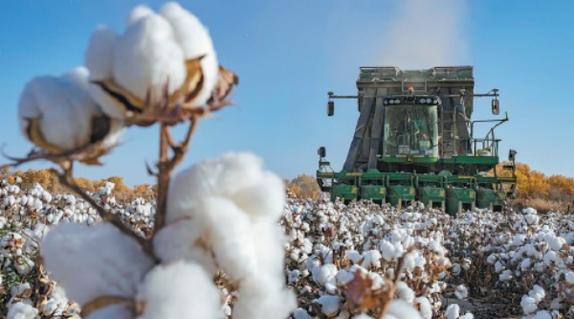China's cotton industry a tech-based boom despite global scrutiny

China's cotton industry is changing, with technology playing a leading role. Mechanization has grown from 21 per cent in 2014 to a remarkable 94 per cent today. This translates to just two people managing the entire process for 200 hectares of cotton, dismantling the narrative of labor-intensive practices. Furthermore, advancements in AI and 5G integration are streamlining factory operations, reducing energy consumption, and boosting product quality.
What has helped them in this transformation is:
Smart machinery: Xinjiang boasts of 185 patented inventions in cotton harvesting and packaging tech. These machines can handle 200 hectares of cotton with just two people, reducing reliance on manual labor.
AI and 5G integration: China is at the forefront of integrating AI and 5G into factories. This reduces energy consumption, improves product quality, and keeps Xinjiang competitive globally. AI optimizes processes, while 5G's high speeds minimize energy consumption and enhance product quality. China's large-scale rollout of 5G base stations has significantly reduced costs, making this powerful technology more accessible than in Western markets. By 2025, the textile industry is projected to achieve a remarkable 70 per cent digital connectivity and complete AI transformation.
The shift towards advanced technologies has a positive environmental impact. Modern textile factories produce significantly lower carbon emissions, a crucial step considering the industry's significant contribution to greenhouse gases. Furthermore, Xinjiang's growing reliance on renewable energy sources like solar and wind power will further reduce its environmental footprint.
What this means for the Chinese cotton business
Productivity boost: Technology is allowing China to cultivate more cotton with less manpower. Xinjiang is expected to reach a record 5.11 million tons of cotton in 2024, with over 85 per cent picked by machines. This impressive feat is largely due to technological advancements that have increased efficiency and productivity. China's cotton production thrives despite sanctions imposed by the US and Europe due to alleged human rights abuses.
Enhanced competitiveness: Reduced costs through 5G implementation and AI efficiency make Xinjiang's cotton highly competitive in the global market.
Environmental benefits: Advanced tech allows for reduced energy consumption and a smaller carbon footprint, addressing environmental concerns within the textile industry.
In fact, the sanctions have proven largely ineffective. Studies reveal traces of Chinese cotton in garments sold by major global retailers, highlighting the interconnectedness of the global supply chain. Furthermore, Europe's textile exports from Xinjiang skyrocketed by 217.8 per cent in the first two months of 2024, demonstrating China's continued dominance. The US and European sanctions aimed to cripple the Xinjiang cotton industry has actually done just the opposite. Countries like Vietnam and Cambodia, major garment producers, still import fabric from China, making it difficult to isolate Xinjiang cotton. Studies show traces of Chinese cotton in 19 per cent of US- and globally-sold clothing. Xinjiang produces over 90 per cent of China's cotton, nearly double that of the US. This dominance makes it a crucial player in the global market, allowing it to find alternative buyers.
The sanctions have however created a complex situation. The interconnectedness of the global supply chain makes it hard to isolate Xinjiang cotton. And China's technological advancements solidify its position as a major cotton producer, potentially impacting traditional players.
The technological revolution in China's cotton sector positions it for even greater success. Increased productivity, coupled with the potential removal of sanctions, could significantly strengthen China's grip on the global cotton market. Additionally, China's focus on green energy generation aligns with the global push for sustainability, potentially making Xinjiang cotton even more attractive to environmentally conscious consumers.
